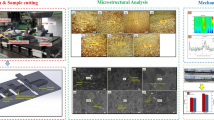Conclusions
-
1.
With rise in the amount of dispersed phase, the hardness of a composite material increases and its ductility decreases, the actual extent of these changes depending upon the chemical composition of the silicate phase.
-
2.
Tests have shown that, at 20°C, the short-time strength is a maximum for pure nickel, and falls with increase in dispersed-phase content.
-
3.
In the test temperature range 20–400°C, a definite correlation is observed between the short-time strength of composite materials and the coefficient of linear thermal expansion of their dispersed silicate phases. In composites with dispersed phases having a low coefficient of thermal expansion, the strengthening effect is more pronounced.
-
4.
A nickel-base composite material containing dispersed silicate phase I possesses the best operating characteristics at 800°C. With decrease in the degree of dispersion of the strengthening phase, the mechanical properties of the material improve.
Similar content being viewed by others
Literature cited
B. L. Rudoi, M. Kh. Shorshorov, et al., Poroshkovaya Met., No. 3 (1974).
R. Z. Vlasyuk, E. S. Lugovskaya, and I. D. Radomysel'skii, Poroshkovaya Met., No. 3 (1969).
R. Z. Vlasyuk, E. S. Lugovskaya, and I. D. Radomysel'skii, Poroshkovaya Met., No. 5 (1971).
R. Z. Vlasyuk and L D. Radomysel'skii, Poroshkovaya Met., No. 7 (1971).
B. L. Rudoi, G. M. Matveev, and L. I. Blokhina, Fiz. i Khim. Obrabotki Material., No. 1 (1973).
G. M. Matveev, B. L. Rudoi, and M. Kh. Shorshorov, Fiz. i Khim. Obrabotki Material., No. 6 (1969).
B. A. Borok, R. D. Zaitseva, et al., Metal. i Term. Obrabotka Metal., No. 3 (1966).
R. L. Sands, A. Phelps, and W. R. Morgan, Powder Met., No. 10, 158 (1962).
L. N. Burminskaya, G. I. Granik, et al., in: Ultrasound in Engineering [in Russian], No. 1, TsNIIPI, Moscow (1966).
E. I. Mozzhukhin, in: Metallurgy of Nonferrous and Rare Metals [in Russian] (1965); Advances in Science and Technology [in Russian], Moscow (1965); Advances in Science and Technology [in Russian], Moscow (1966).
Author information
Authors and Affiliations
Additional information
Translated from Poroshkovaya Metallurgiya, No. 4 (136), pp. 17–22, April, 1974.
Rights and permissions
About this article
Cite this article
Rudoi, B.L., Shorshorov, M.K., Matveev, G.M. et al. Physicomechanical properties of nickel-base composite materials with dispersed crystallizing glass particles. Part II. Powder Metall Met Ceram 13, 271–275 (1974). https://doi.org/10.1007/BF00796799
Received:
Issue Date:
DOI: https://doi.org/10.1007/BF00796799




